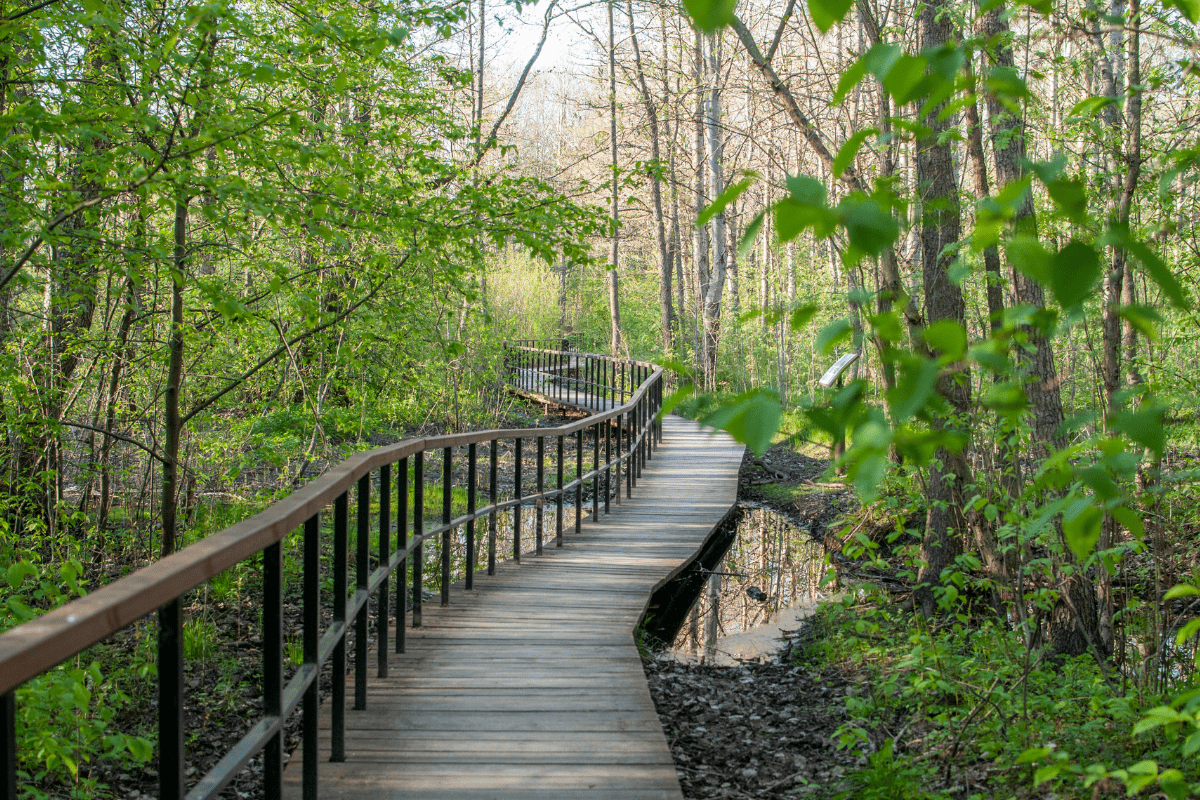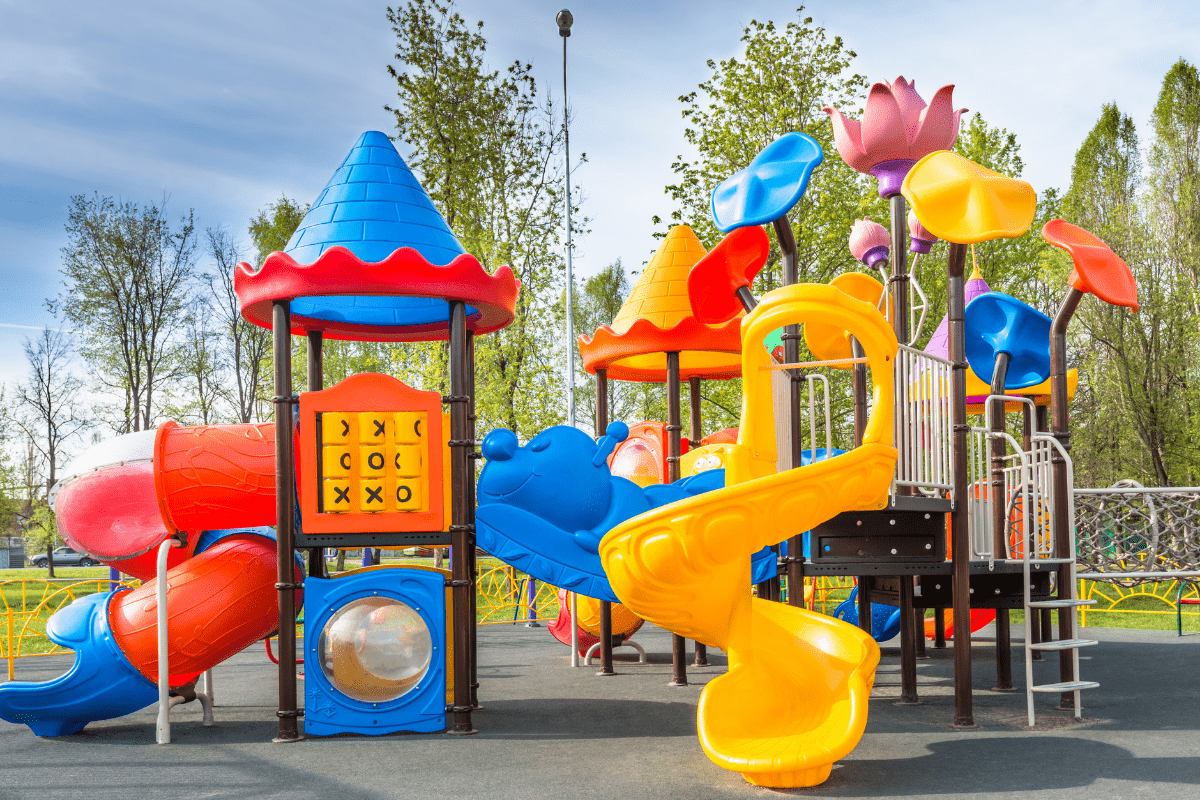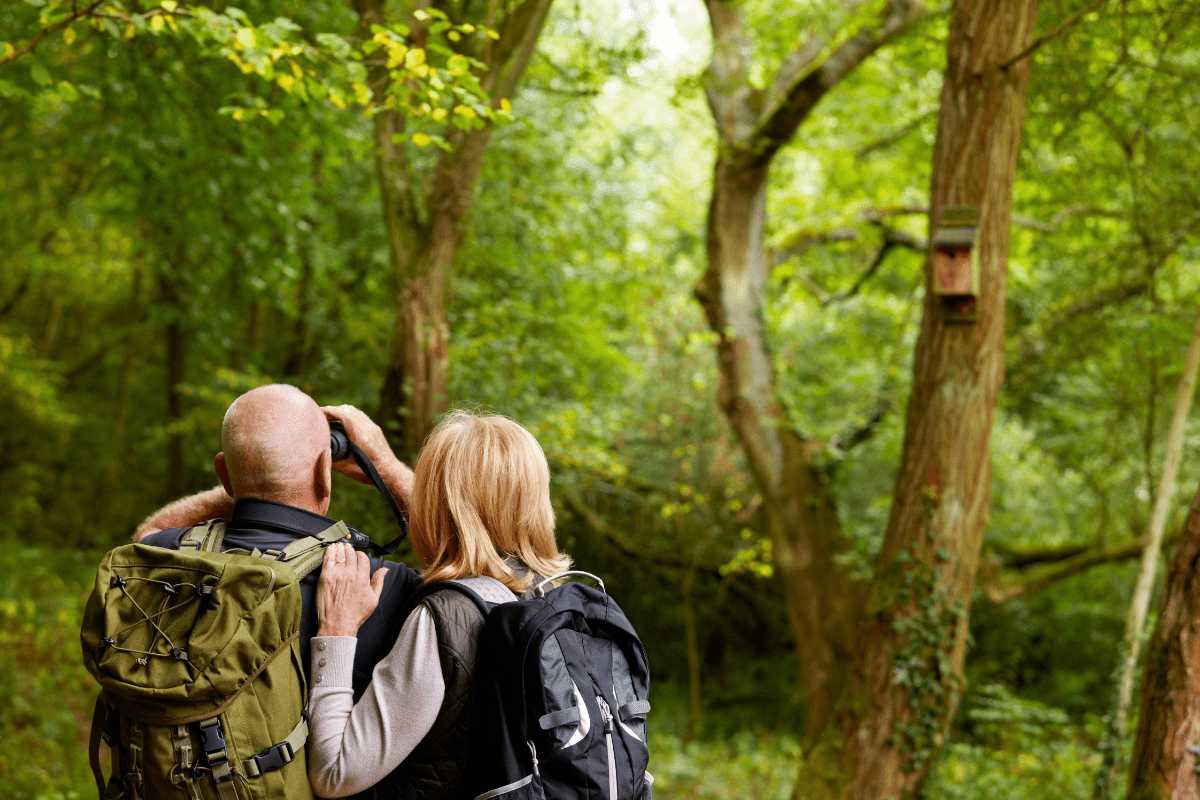Whether you crave shaded strolls beneath Spanish moss or want to spot wildlife along tranquil marshes, the trails surrounding Savannah promise scenery and serenity for every skill level. From lake loops to wild island hikes, there’s something here for birdwatchers, runners, families, and anyone looking to unwind outdoors.
Let’s get to it.
Forsyth Park
This 30-acre park in Savannah offers wide paved sidewalks that can handle a small parade, with live oaks draped in Spanish moss providing shade throughout. A one-mile loop follows almost flat terrain with just a brief rise of six feet. There are statues scattered around and a water fountain at the center that attracts plenty of selfies. The café near the park entrance serves coffee, pastries, and light snacks.
In spring, blooming azaleas line the pathways. A playground and café serve families, and rows of benches are set up for people-watching breaks. Street parking lines the surrounding streets, and paths are wheelchair and stroller friendly. Signs indicate accessible routes and restrooms near the café remain clean year-round. Dogs must remain leashed, which works well alongside runners, tourists, and birdwatchers sharing the routes. The park stays busy on weekend mornings but remains open and well maintained all year, even when summer temperatures rise.
Skidaway Island State Park
At Skidaway Island State Park, most trails are classified as easy, making this a great spot for casual walks. Park maps and trail guides are available at the entrance kiosk. The Sandpiper Trail is a stroller-friendly one-mile loop that crosses marsh views and boardwalks over tidal creeks. Observation decks and benches sit beneath live oaks hung with Spanish moss. ADA accessibility features include ramps and level surfaces.
The Big Ferry Trail stretches about 3 to 3.5 miles on mostly flat ground. Along the way, hikers will notice Civil War earthworks and sites linked to Prohibition-era stills. Dogs on leashes are welcome, and waste stations are provided. Restrooms and water fountains are located near the trailheads. Trails are well maintained with clear maps. In summer, mosquitoes and humidity increase, but shade helps keep the area inviting.
Oatland Island Wildlife Center
Oatland Island Wildlife Center features a flat two-mile loop through maritime forest, salt marsh, and wooden boardwalks. The elevation change is only 29 feet total, so it is accessible for strollers and wheelchairs. Trail surfaces alternate between asphalt, packed dirt, and sand but remain mostly easy to follow. Trail edges are lined with native shrubs and interpretive signs describing plants and habitats. Clear signage and occasional weathered boardwalk planks mark the route well.
Animals on display include wolves, birds of prey, farm creatures, and alligators viewed from safe enclosures. Covered viewing shelters and picnic pavilions offer shade and seating. Restrooms and water taps are positioned roughly every half mile. Benches between exhibits allow visitors to rest. Pets are not allowed unless they serve as assistance dogs. Spring and fall bring ideal weather and active wildlife, while summer calls for extra water and insect repellent.
Whitemarsh Preserve
Whitemarsh Preserve sits just beyond Savannah and swaps city noise for peaceful dirt and boardwalk paths. The main Island Trail is wide enough for strollers, wheelchairs and leashed dogs, and a paved section runs parallel to a twistier mountain-bike loop. Both routes stay firmly in the “easy” category, with minimal elevation and a mix of salt marsh and swamp scenery.
Spanish moss drapes the live oaks overhead, keeping the trail shaded and cool. Volunteers and county staff maintain clear pathways, and a single-track section appeals to mountain bikers without overwhelming other users. Visitors often spot herons, egrets and small marsh wildlife along the way.
Parking is available at the entrance, and trail maps help you choose your route. Bring insect repellent during peak mosquito season to stay comfortable. The Preserve remains open year-round, offering a steady stream of dog walkers, birdwatchers and locals seeking a break from traffic noise.
Lake Mayer Park
Known for its mix of paved trails and lakefront scenery, Lake Mayer Park offers a little something for every visitor. The main 1.4-mile Lake Mayer Loop is flat and fully paved, with a cushioned rubber track running alongside. As you circle the lake, you’ll enjoy uninterrupted water views and frequent sightings of ducks, herons and coots.
Branching off, the Truman Linear Trail extends about 7 miles along Casey Canal. This quieter route welcomes dogs on leash and features both pavement and boardwalk sections. Benches and rentable pavilions dot the path, and restrooms and water fountains appear at regular intervals. Tennis courts, playgrounds and ample parking complete the picture. With just nine feet of elevation change, both loops stay accessible and easy on the knees.
Whether you’re out for a brisk walk or a family outing, Lake Mayer Park delivers broad lake vistas, diverse wildlife and all the amenities you need for a day outdoors.
UGA Marine Education Center and Aquarium
The UGA Marine Education Center and Aquarium blends interactive exhibits with access to the adjacent Jay Wolf Nature Trail. Inside, you’ll find touch tanks featuring sea stars, small crabs and other coastal creatures alongside displays on local fish, jellyfish and seahorses.
Outside, two trail loops start at the main parking area. The shorter loop covers about 0.5 mile beneath a maritime forest canopy. The longer loop stretches 0.85 mile and includes a boardwalk over marsh grasses with views of the Skidaway River. The boardwalk is ADA-compliant and stroller-friendly, making it easy to bring both young children and older visitors. Along the trails, you’ll pass an old whiskey still, an Interpretive Cabin and neat demonstration gardens.
Most days remain peaceful, so you might spot birdwatchers or a dog on leash but few crowds. Spring brings wildflowers, and fall is prime for migratory bird sightings. Restrooms are located inside the aquarium, and a covered picnic pavilion with benches stands just outside the trails. The facility is open daily.
Emmet Park
Emmet Park offers a half-mile paved walkway along Bay Street with minimal elevation change. Decorative lampposts line the path and stone ramps lead down to a cobblestone riverfront area. Live oaks provide shade, and benches line the route for resting or observing passersby. The park includes several historic monuments, such as a Celtic Cross and memorials to Vietnam and Korea veterans.
Leashed dogs are permitted, and nearby street parking is generally available. Cobblestone steps connect to the river edge, supplying views of passing boats. The park fills up during St. Patrick’s Day events but remains moderately busy for the rest of the year. Paths are clean and stroller-friendly, making the area accessible for visitors of all ages. Regular maintenance ensures safety and comfort throughout the seasons.
Daffin Park
Daffin Park covers 77 acres and features a 1.2-mile flat loop that works well for walking, biking, or jogging. The circuit includes a cushioned rubberized running track along one side. Lighting along the path supports early morning and evening visits. Around the central lake, live oaks form a canopy and benches offer resting spots.
A 0.33-mile well-lit lakeside path is popular for evening strolls, attracting couples, families, and pet owners. The park also includes ball fields, courts for basketball and tennis, a fenced dog area, and numerous picnic tables. Scoreboards and trash receptacles help keep the area neat. Parking is abundant and paths stay clean. Restrooms and water fountains are maintained regularly. Local sports leagues use the fields on weekends, but on most days the park remains uncrowded. Overall, the park delivers a reliable experience in a relaxed setting.
Savannah Ogeechee Canal Museum and Nature Center
At the Savannah Ogeechee Canal Museum and Nature Center, history and nature share the same towpath trail. The main loop covers about three miles over a mix of dirt, exposed roots and solid boardwalks that cross wetlands. Along the path, you’ll pass 19th-century barge locks, remnants of canal engineering and stands of palmetto scrub.
The adjacent museum houses exhibits on canal freight transport before the railroad era. Interpretive signs along the trail explain how locks functioned and why the canal mattered. Parking and restrooms sit on-site, and a picnic pavilion offers a shaded spot for lunch.
For a quieter walk, try the Half Moon Lake Trail. Under one mile long, it threads through woodland and crosses a sturdy wooden bridge. Watch your step after rain, since sections can become muddy quickly. Both trails welcome leashed dogs and close at dusk. Between museum displays and waterside views, the canal center provides a practical blend of local history and outdoor exploration.
Wormsloe State Historic Site
Wormsloe State Historic Site combines centuries-old ruins with a grand live oak avenue and easy walking loops. The site opens with a famous mile-long entrance lined by 400 live oaks draped in Spanish moss. Beyond that, a three-mile loop trails along salt marsh edges, through wooded stretches and past deer-frequented clearings.
Along the route, you’ll discover the ruins of the 18th-century tabby structure, built of oyster-shell concrete, plus interpretive signs that explain each site. Benches appear at scenic overlooks, and a low-key shuttle offers a ride if you’d prefer less walking. The paths remain mostly flat, making them suitable for strollers and wheelchairs.
Dogs on leash are welcome, restrooms are plentiful and the gift shop provides a handy break. Early morning visits tend to be quieter, while midday draws more visitors at the oak tunnel. Summer calls for bug spray, as marsh mosquitoes can be persistent. Overall, Wormsloe delivers history, nature and easy access in one well-preserved package.
Joseph Tribble Park
Joseph Tribble Park may not be the flashiest spot, but it scores high on convenience. The heart of the park is an 11-acre lake encircled by a smooth, paved 0.7-mile loop. The eight-foot-wide asphalt path is free of pebbles, roots, and steep grades, making it ideal for scooters, strollers, or a relaxed jog. Benches appear at frequent intervals, inviting brief pauses by the water. A traditional playground sits nearby, and several picnic tables and covered pavilions stand ready for gatherings. Restrooms are located close to the play area.
Accessibility at Tribble Park is solid. Parking spots feature striped aisles for wheelchair and stroller access. The path is well lit for early evening visits. Leashed dogs are allowed and there are trash bins for waste. Weekend visits in spring and fall bring a bit more traffic but nothing overwhelming. Most visitors enjoy quiet lake views, occasional duck sightings, and low-effort exercise. Parking is free on paved lots, and park staff keep debris in check. Maintenance crews remove fallen branches and clear leaves, ensuring the trail stays clear year-round.
Savannah Botanical Gardens
Savannah Botanical Gardens offers ten acres of easygoing walkways set on flat ground. Most paths are paved or packed dirt. Several boardwalks meander along the pond and over a small bog.
Formal sections showcase rose beds and a neat herb garden. Natural zones feature fern glades and wetland plants. A camellia collection adds seasonal color and evergreen structure. Leashed dogs are welcome and waste stations appear along the routes.
Admission and parking are free, and benches line the paths every few yards. Public restrooms stand near the main entrance and seem well maintained. A small picnic area under oak trees invites quiet lunches. Weekday visits stay calm, attracting locals who explore the old Reinhard House and its archaeological displays.
Volunteers maintain the grounds year-round, clearing storm debris and tending plantings. The result is a relaxed, well-kept setting that balances formal horticulture with native habitats.





